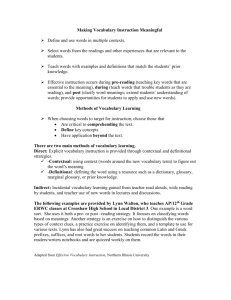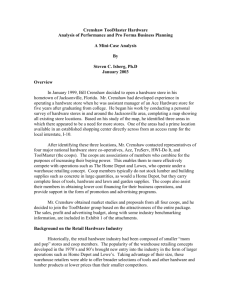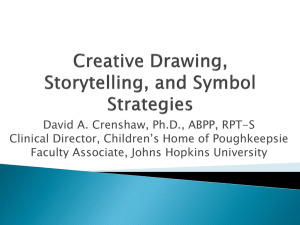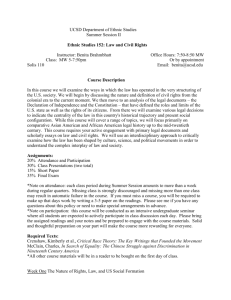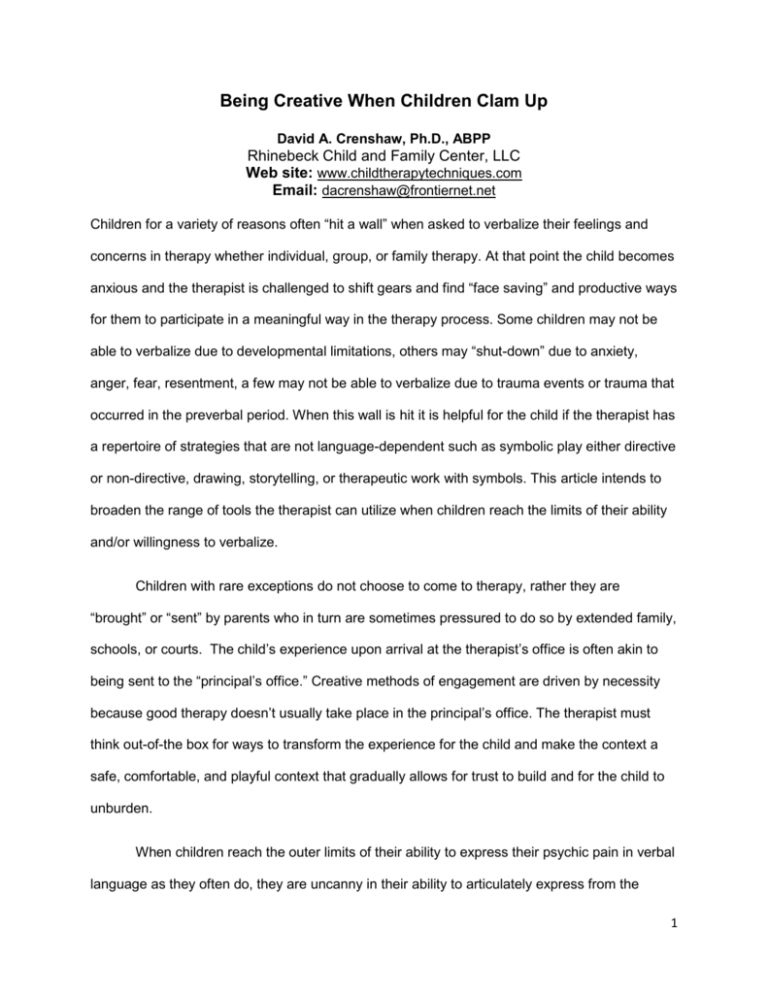
Being Creative When Children Clam Up
David A. Crenshaw, Ph.D., ABPP
Rhinebeck Child and Family Center, LLC
Web site: www.childtherapytechniques.com
Email: dacrenshaw@frontiernet.net
Children for a variety of reasons often “hit a wall” when asked to verbalize their feelings and
concerns in therapy whether individual, group, or family therapy. At that point the child becomes
anxious and the therapist is challenged to shift gears and find “face saving” and productive ways
for them to participate in a meaningful way in the therapy process. Some children may not be
able to verbalize due to developmental limitations, others may “shut-down” due to anxiety,
anger, fear, resentment, a few may not be able to verbalize due to trauma events or trauma that
occurred in the preverbal period. When this wall is hit it is helpful for the child if the therapist has
a repertoire of strategies that are not language-dependent such as symbolic play either directive
or non-directive, drawing, storytelling, or therapeutic work with symbols. This article intends to
broaden the range of tools the therapist can utilize when children reach the limits of their ability
and/or willingness to verbalize.
Children with rare exceptions do not choose to come to therapy, rather they are
“brought” or “sent” by parents who in turn are sometimes pressured to do so by extended family,
schools, or courts. The child’s experience upon arrival at the therapist’s office is often akin to
being sent to the “principal’s office.” Creative methods of engagement are driven by necessity
because good therapy doesn’t usually take place in the principal’s office. The therapist must
think out-of-the box for ways to transform the experience for the child and make the context a
safe, comfortable, and playful context that gradually allows for trust to build and for the child to
unburden.
When children reach the outer limits of their ability to express their psychic pain in verbal
language as they often do, they are uncanny in their ability to articulately express from the
1
depths of their soul the pain beyond words in the language of play, artistic images or symbols.
Just as the poet is said to be able to “create harmony out of chaos”, the child becomes the poet
who uses not words but creative modes of expression to create harmony out of inner chaos or
to make sense of a shattered relational world. The child can do this with a precision that would
be the envy of even a Keats, Byron, or a Shelly. Drawing on the work of Allan Schore, play,
artistic depiction, and use of symbols is the language of the right hemisphere that is dominant in
the first three years of life while the left hemisphere does not even come on line until about
fifteen months. Play, drawing, and use of symbols thus permit access to trauma occurring in the
preverbal period. Examples of therapy tools developed by the author are offered on the
following pages that engage the child in an active and interactive therapy process when verbal
expression reaches a natural limit. I wish to emphasize that these are tools that can be
integrated in a wide range of therapy approaches and theoretical models, but they are not the
therapy itself, rather they are simply tools.
Three Doors
©David A. Crenshaw, Ph.D., ABPP
Theme: Therapeutic Exploration of key issues of loss, disappointment, and hopes and dreams
for the future
Recommended Age Range: Nine to Seventeen
Treatment Modality: Individual, Group, and Family Therapy
Goals:
1)
To offer older children and teens structure that facilitates communication about
important losses and disappointments
2)
To facilitate therapeutic communication about what is valuable and worth holding
onto from their past
3)
To further therapeutic exchange regarding hopes and dreams for the future
2
4)
To highlight strengths and resilience
Materials
Paper, Pencil, Markers, Colored Pencils, Crayons
Description
The child is asked to imagine what is on the other side of the three doors. The first door is the
door to their past that opens to whatever disappointments, losses, or setbacks that they’ve
experienced. These are experiences they may wish to put behind them. The second door opens
to the things they want to hold on to from their past. These could be happy memories,
relationships, skills, or lessons learned that they value and wish to keep. The third door opens to
their hopes and dreams for their future. The child can either describe to the therapist what is
behind each door, or write, or draw or to use miniatures to symbolize what is to be found on the
other side of each door. The therapeutic value of this activity will rest largely on the ability of the
therapist to take what the client expresses and expand on it to create meaningful and heartfelt
exchange around issues central to the child’s emotional life.
Discussion
This therapeutic activity like many others previously described (Crenshaw, 2006; Crenshaw,
2008a; Crenshaw & Mordock, 2005) gives children and teens the tools to discuss matters in
therapy that are emotionally significant that they may wish to talk about but cannot easily initiate
the therapeutic conversation. The therapist can, however, structure the therapeutic session by
using such activities to enable them to more easily share their inner feelings and in this instance
some of their regrets, disappointments, as well as valuable lessons learned from their past,
ways that their past hurtful experiences may have strengthened them and their hopes and
dreams for the future.
This activity is intended to honor the strengths-based approach and the view that children can
gain strength and hardiness from weathering some of the disappointments and setbacks in their
past and challenges them to seek out what they would want to hold onto and carry forward from
their past. This focus draws on the Solution-Focused approach to therapy as pioneered by
Insoo Kim Berg and her colleagues. This activity is informed by the strengths-based,
competency approach to therapy (Brooks & Goldstein, 2001; Brooks & Goldstein, 2004; Brooks
& Goldstein, 2007; Waters & Lawrence, 1993). Garbarino (2008) observed, “All of us have some
capacity to deal with adversity, but some of us have more than others and thus more resilient,
whereas others are more vulnerable in difficult times” (p.7). In pursuing the door to the past it is
important for clinicians to balance the recognition of and honoring of strengths without in any
way minimizing the genuine suffering caused by harsh experiences in life or painful losses
(Crenshaw, in press).
Likewise, clinical sensitivity is required in pursuing the open door that leads to the child’s hopes
and dreams (Crenshaw, 2008a; Crenshaw, 2008b). Some children because of the adversities
they have faced in life keep their expectations low, a way of coping known as the “survival
orientation” (Hardy & Laszloffy, 2005). They cannot afford “the luxury of hope” (Crenshaw,
2008a; 2008b). While hopes and dreams are vital forces in the lives of children, it can in some
cases fortify them for facing tough challenges but is some cases may be regarded as dangerous
to their psychological well-being if their hopes and dreams have been crushed too many times.
3
Thus the third door offers insight into a child’s reliance on hopes and dreams to sustain them in
their quest for a better life.
One of the advantages of this strategy is the wide range of choices offered to children and teens
from direct verbal expression to drawing, therapeutic writing or even the use of symbols to
communicate their inner life.
References
Brooks, R. & Goldstein, S. (2001). Raising resilient children. New York: McGraw- Hill.
Brooks, R. & Goldstein, S. (2004). The power of resilience: Achieving balance, confidence, and
personal strength in your life. New York: McGraw-Hill.
Brooks, R. & Goldstein, S. (2007). Raising a self-disciplined child. New York: McGraw-Hill.
Crenshaw, D. A. (2008a). Therapeutic engagement of children and adolescents. Lanham, MD:
Jason Aronson, an imprint of Rowman & Littlefield Publishers.
Crenshaw, D.A. (Ed.). (2008b). Child and adolescent psychotherapy: Wounded spirits and
healing paths. Lanham, MD: Lexington Books.
Crenshaw, D. A. (ed.) (in press). Reverence in healing: Honoring strengths without trivializing
suffering. Lanham, MD: Jason Aronson/Rowman & Littlefield.
Garbarino, J. (2008). Children and the dark side of human experience: Confronting global
realities and rethinking child development. New York: Springer.
Hardy, K. V., & Laszloffy, T. (2005). Teens who hurt: Clinical interventions to break the cycle of
adolescent violence. New York: Guilford Press.
Waters, D. & Lawrence, E. (1993). Competence, courage & change: An approach to family
therapy. New York: Norton.
© Copyright 2009 by David A. Crenshaw, Ph.D. All rights reserved.
Heartfelt Feelings Coloring Cards Strategies
© David A. Crenshaw
Theme: Feelings Expression
Recommended Age Range: Six to twelve for the expressive domain; Nine to twelve for the
relational domain
Treatment Modalities: Individual, Group, Family
4
Goals
● Teach feelings and vocabulary for identification and expression
● Increase awareness and expression of heartfelt feelings in relation to the key attachment
figures in the child’s life
●
Explore sensitive issues and heartfelt matters with children in a way that is non-threatening
and leads to greater disclosure and gradual exposure to the avoided painful material
Materials
● The Heartfelt Feelings Coloring Card Strategies (HFCCS) Kit that includes a Clinical Manual
and 20 expressive and 20 relational cards. The kit can be ordered from the Coloring Card
Company (www.coloringcardcompany.com ) or by calling (908) 237–2500. Additional sets of
cards can be ordered as needed.
●
Crayons, markers, or colored pencils for the child to color the heart, and pencils or pens for
the child to write in the card
Description
The Heartfelt Feelings Coloring Card Strategies (HFCCS) Kit is a series of strategies that use
the potent symbol of the heart shape in therapeutic activities. The strategies are inviting and
natural to children (coloring and writing in greeting cards) and can be used in play therapy, child
therapy, family therapy, group therapy, and art therapy to facilitate the expression and sharing
of heartfelt emotions (Crenshaw, 2007, 2008).
The greeting cards were developed in collaboration with the Coloring Card Company, which
makes greeting cards for children created by child artists. The HFCCS has the unique feature of
emphasizing two core domains: the expressive and the relational. In the Expressive domain the
child is instructed to pick a feeling from a group of 40 emotions in the Clinical Manual. The
feelings are arranged from simple such as “sad” to more complex such as “perplexed” — the
latter would be appropriate for children at the upper limit of the age range.
The child is then directed to pick a color to go with the feeling. If the child picks blue for sad, for
example, she/he will then be asked to color in the heart on the front of the greeting card with the
color blue. When finished, the child is instructed to write about a time when her/his heart was
filled with sadness on the inside of the card on the lines provided. This gives the child an
opportunity to express the heartfelt feeling in the context that produced the feeling. If the child is
too young to write, she/he can dictate the response and the practitioner can write it on the inside
of the card.
In the relational domain the clinical manual contains specific directives for the child that allows
for exploration of their social world, for example, “Draw in the heart on the front of the card a
person who once was in your heart but no longer is.” The relational component consists of
systematic exploration of the heartfelt feelings in connection with key attachment figures and
with important persons in the child’s interpersonal world. The relational cards have the heart
5
shape on the front of the card but the instructions on the inside of the card are different from the
expressive cards. Using the example above, the child would be asked on the inside panel of the
card to write or dictate a note to the person who was once in their heart but no longer is.
Discussion
Many practitioners have used some variation of the heart shape in child, play, art therapy and
other creative arts therapies. The expressive domain offers structured therapeutic practice in
identifying, labeling, and expressing feelings. These are key skills in affect regulation and for
developing social competence. Allan Schore (2003a; 2003b), in his groundbreaking work on
affect regulation, has demonstrated that affect dysregulation is central to almost all forms of
psychopathology. Therapeutic interventions that address this crucial deficit will have wide
application across the psychodiagnostic spectrum.
The relational domain emphasizes that our most heartfelt emotions do not develop in a vacuum.
They develop in an interpersonal context. The social context is critical. Some children get angry
at school but not at home. The main value of this therapeutic activity is that it creates an entry
point for the child to further explore her/his heartfelt feelings and the interpersonal context that
elicits them.
The Clinical Manual also contains a number of variations of the HFCCS for use in bereavement
work, supervision, examining countertransference feelings, and highlighting strengths in the
child, group, or family therapy.
References
Crenshaw, D.A. (2007). The Heartfelt Feelings Coloring Card Strategies (HFCCS). Flemington,
NJ: The Coloring Card Company, Inc.
Crenshaw, D.A. (2008). Therapeutic engagement of children and adolescents: Play, symbol,
drawing, and storytelling strategies. Lanham, MD: Jason Aronson.
Schore, A.N. (2003a). Affect dysregulation and disorders of the self. New York: Norton.
Schore, A.N. (2003b). Affect regulation and the repair of the self. New York: Norton.
Heart Symbol Strategies
©David A. Crenshaw
Theme: Feelings Expression
Recommended Age Range: 6 to 17
Treatment Modality: Individual, Group or Family
Goals
6
● To create and expand on a potentially healing therapeutic dialogue about important losses
and disappointments in the child’s life
● To identify and highlight important interpersonal resources that are critical to a child at a time
of emotional crisis
Materials
A collection of hearts of a wide variety of shapes and colors and materials can be easily
obtained at novelty shops. The collection can include plastic, felt, glass and gem stone
materials. Children are fascinated by the beauty and variety of the hearts in the collection. The
hearts can be placed in a leather-bound and velvet lined jewelry box that adds further mystique
and value to the collection as perceived by the children.
Description
The “Velvet-Lined Box of Hearts”
The child is asked to pick from a collection of hearts in a leather bound and velvet-lined jewelry
box a heart that symbolizes someone important whom they miss—someone they do not see at
all (a person who died or someone who moved away) or someone they do not see as often as
they wish. They can pick more than one heart to represent each of the persons they are
missing. On inquiry, the child is asked to tell why they picked that particular heart for each of the
persons they are missing, and to talk about that important person who is presently missing from
their life.
The “Circle of Hearts”
The child is instructed to pick a heart from the velvet-lined box of hearts to represent the self.
Then the child is asked to pick a heart for every person that loves them. These hearts are
arranged in a circle around the heart they have picked for self. If children are unable to make a
full circle of people who love them, they then should be directed to place also in the surrounding
circle a heart representing friends, peers or adults who care about them or support them. If they
are still unable to complete the circle the children can be asked to pick a heart to represent
people who they would like to be able to turn to for love and support.
Discussion
The heart symbol has been a potent symbol in cultures around the world throughout the ages.
For many, the heart symbolizes love, for others passion, or the emotional center of the person.
Among the strategies previously described are the Heartfelt Feelings Strategies (GoodyearBrown, 2002; Riviere, 2005; Crenshaw, 2008) and the Heartfelt Feelings Coloring Card
Strategies (Crenshaw, 2007). The strategies above build on the previous ones by using the
heart shape in symbol therapy work.
As with all strategies that are evocative of emotion, sometimes quite powerful emotions, only the
clinician working with the child or family or group of children can decide if such a strategy would
7
be appropriate for a given client(s) at a particular time. Obviously, timing and pacing are critical
factors in clinical decision making, as well as a thorough understanding of the child’s level of
functioning at any one point in time, including the ability to tolerate anxiety and emotional
distress. The level of external stress in the child’s life at the given point of time also needs to be
considered. It is impossible to overemphasize the factor that repeatedly has been demonstrated
empirically to have the most bearing on psychotherapy outcome, the quality and strength of the
therapeutic alliance. The ultimate goal is to expand emotionally meaningful and heart-centered
dialogue with the child, family, or group that contributes to the healing process.
References
Brown Goodyear, P. (2002). Digging for buried treasure. Antioch, TN: Paris Goodyear Brown.
Crenshaw, D.A. (2007). The Heartfelt Feelings Coloring Card Strategies (HFCCS).
Rhinebeck, NY: Rhinebeck Child & Family Publications
Crenshaw, D. A. (2008). Therapeutic engagement of children and adolescents: Play, symbol,
drawing, and storytelling strategies. Lanham, MD: Jason Aronson/ Rowman & Littlefield
Publishers.
Riviere, S. (2005). Play therapy to engage adolescents. In L. Gallo-Lopez and C. E. Schaefer,
(Eds.), Play therapy with adolescents, 2nd ed. (pp.121-142). Lanham, MD: Jason
Aronson/Rowman & Littlefield.
The Magic Key
©David A. Crenshaw
Therapeutic Engagement of Children and Adolescents: Play, Symbol, Drawing, and Storytelling
Strategies (2008) Jason Aronson Publishing
Theme: Therapeutic Exploration of Losses
Recommended Age Range: Nine to Fourteen
Treatment Modality: Individual, Group, and Family Therapy
Goals:
1)
2)
3)
4)
Verbally identify key issues to address in therapy
Increase awareness of losses, particularly unacknowledged or disenfranchised grief
Verbally express denied or disconnected feelings about prior losses
To expand therapeutic dialogue about the issues that matter most to the child
Materials
8
Paper
Markers
Pencil or Colored Pencils
Crayons
Description
Read the following instructions to the child:
Imagine that you have been given a magic key that opens one room in a huge castle. There are
four floors in the castle and since the castle is huge there are many rooms on each floor, but
your magic key only opens one of the many, many rooms in the castle. Pretend you go from
room to room, and from floor to floor, trying your magic key in each door until you finally come to
the door that your key opens. You turn the key and the lock opens. Because you have been
given a magic key that only opens this door, what you see is the one thing that money can’t buy
that you always thought would make you happy. Pretend that you are looking into the room.
What is it that you see? What is that one thing that has been missing that money can’t buy that
you always thought would make you happy? When you have a clear picture, please draw it as
best you can.
Discussion
Projective drawing and storytelling strategies along with therapeutic play and the use of symbols
are central to tools used in therapy with children and adolescents (Crenshaw, 2004; 2006;
2008). The Magic Key (Crenshaw, 2004, Crenshaw & Mordock, 2005; Crenshaw, 2008), is a
projective drawing strategy that was developed to evoke themes of loss, longing, and missing in
the lives of children.
In early versions of this strategy, the caveat “that money can’t buy” was not included in the
directions. It is not surprising in this highly consumer-oriented culture that many children drew a
big screen television or the latest video game console. Some children, however, drew a missing
or deceased parent, a safe home they never experienced, or a family where the parents don’t
argue. They drew a home they always longed for, one that sadly was missing in their lives. By
adding the qualifier “that money can’t buy” the strategy focuses the child on essential emotional
needs that have not been met or important losses that the child has suffered rather than the
latest electronic gadget or toy.
This projective drawing strategy is especially useful with children whose lives are replete with
loss. Many severely aggressive children have suffered profound, multiple losses (Crenshaw &
Garbarino, 2007; Crenshaw & Hardy, 2005; Crenshaw & Mordock, 2005). This strategy is one of
the ways to access these feelings when children are disconnected from their emotions or have
great difficulty verbalizing their painful affect. Issues of timing and pacing, including the
readiness of both the child and therapist to undertake emotionally focused work, are critical.
Before using this tool readers should review the Play Therapy Decision Grid (Crenshaw and
Mordock, 2005) and determine whether the child is appropriate for the Coping or Invitational
Track of therapy. This technique should only be used with children judged to be ready for the
Invitational Track. Children appropriately assigned to the Invitational Track will be judged to
have adequate ego strengths, mature defenses, ability to manage anxiety and the ability to
tolerate and contain strong emotion without becoming overwhelmed. The child in the Invitational
9
Track will not show signs of “spillover” from therapy sessions resulting in disruptive anxiety and
behavior during or immediately following the session. The name of the Invitational Track is
meant to imply that the child is invited to go as far as he or she can at any one point in time in
approaching the painful affect or events that need to be faced and resolved.
Tools, such as the Magic Key, are meant to expand and enrich the therapeutic dialogue
between therapist and child and do not constitute the therapy itself. The therapy process entails
much more than the application of tools such as this but they can facilitate meaningful exchange
and therapeutic dialogue which can aid the healing process. Whatever drawing the child
produces in response to the directions to the Magic Key serves as a springboard to elicit more
of the child’s feelings, wishes, fears, dreams, hopes, and serves to create a portal of entry to the
child’s inner life.
References
Crenshaw, D. A. (2004). Engaging resistant children in therapy: Projective drawing and
storytelling strategies. Rhinebeck: NY: Rhinebeck Child and Family Center Publications.
Crenshaw, D. A. (2006). Evocative strategies in child and adolescent psychotherapy. New York:
Jason Aronson (An imprint of Rowland & Littlefield Publishing Co).
Crenshaw, D. A. (2008). Therapeutic engagement of children and adolescents: Play, symbol,
drawing, and storytelling strategies. New York: Jason Aronson (An imprint of Rowland &
Littlefield Publishing Co).
Crenshaw, D. A. & J.B. Mordock (2005). Handbook of play therapy with aggressive children.
New York: Jason Aronson (An imprint of Rowland & Littlefield Publishing Co).
Crenshaw, D. A. & Garbarino, J. (2007). The hidden dimensions: Profound sorrow and buried
human potential in violent youth. Journal of Humanistic Psychology, 47, 160-174.
Crenshaw, D.A. & Hardy, K.V. (2005). Understanding and treating the aggression of
traumatized children in out-of-home care. In N. Boyd-Webb (Ed.), Working with
traumatized youth in child welfare, (pp. 171-195). New York: Guilford.
About The Author
David A. Crenshaw, Ph.D., ABPP is a Board Certified Clinical Psychologist by the American
Board of Professional Psychology, a Registered Play Therapist-Supervisor by the Association
for Play Therapy. Dr. Crenshaw is Founder and Director of the Rhinebeck Child & Family
Center, in Rhinebeck, NY, which provides training and consultation to programs and clinicians
serving at-risk kids. He served as Clinical Director of two residential treatment centers for
children at-risk during a thirty year span. He is Past-President of the New York Association of
Play Therapy. Dr. Crenshaw is the author of Therapeutic Engagement of Children and
Adolescents: Play, Symbol, Drawing and Storytelling Strategies; Evocative Strategies in Child
and Adolescent Psychotherapy; co-author with John B. Mordock of the Handbook of Play
Therapy with Aggressive Children and Understanding the Aggression of Children: Fawns in
Gorilla Suits. He is the editor of a new book: Child and Adolescent Psychotherapy: Wounded
Spirits and Healing Paths. A forthcoming edited book to also be published by Jason
Aronson/Rowman & Littlefield is called: Reverence for Healing: Honoring Strengths without
Trivializing Suffering.
© David A. Crenshaw
10
11


